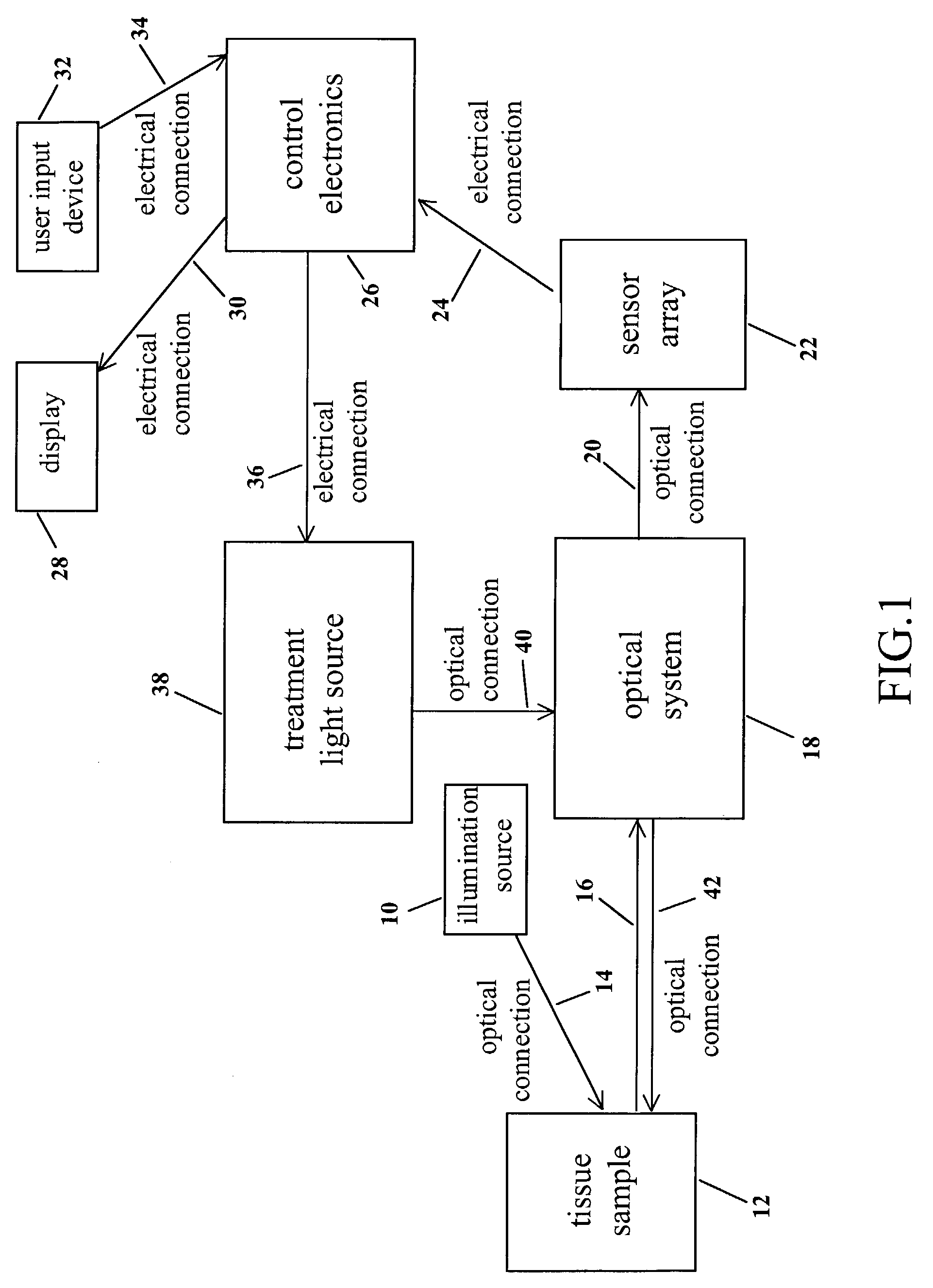Cancer detection and adaptive dose optimization treatment system
a treatment system and cancer technology, applied in the field of cancer detection and precancer treatment systems, can solve the problems of two-part problem, difficult detection of emitted light, and discrimination between light emitted from normal cells and light emitted from cancerous or precancer cells, and achieve the effect of improving patient comfort, cost containment and health outcomes
- Summary
- Abstract
- Description
- Claims
- Application Information
AI Technical Summary
Benefits of technology
Problems solved by technology
Method used
Image
Examples
first embodiment
[0029]The action of this first embodiment of the invention 50 is separated in two distinct phases. The first phase of the action is depicted in FIG. 2A and the second phase of the action is depicted in FIG. 2B.
[0030]As shown in FIG. 2A and FIG. 2B, all the components of this embodiment of the invention 50 are enclosed within and / or attached to a housing 52. Referring to FIG. 2A, in the first phase of the action, an illumination source 54 is used to illuminate a target tissue sample 56 with optical radiation 58. The illumination source 54 may emit optical radiation 58 of any range of wavelengths. For example, the illumination source 54 may emit ultraviolet radiation 58 in the range 340-380 nm. Or the illumination source 54 may emit white light 58 in the range 400-700 nm. Or the illumination source 54 may emit infrared radiation 58 in the range 600-900 nm. Or the illumination source 54 may emit a combination of ultraviolet, visible, and / or infrared illumination 58. Furthermore, the va...
second embodiment
[0043]In this second embodiment, the multiple imaging optical system 218 comprises a plurality of imaging lens elements 220, a set of filters arranged in a plane 222, and a beam-splitting pyramid prism 224. The exact construction and action of the multiple imaging optical system 218 may, preferably, be as described below.
[0044]The multiple imaging optical system uses a series of optical elements to produce multiple simultaneous adjoining images on a single image plane. A first, intermediate, image is produced using the first telecentric imaging lens. This intermediate image is produced at a plane coincident with an adjustable-size rectangular field stop. The rectangular field stop is mounted in a sub-housing that allows its free rotation. A second telecentric lens collimates the light from the intermediate image. This collimated light is next passed through an optical splitting means, which uses the principal of refraction to separate the light into multiple components. The optical ...
third embodiment
[0051]FIG. 6 shows a schematic illustration of a third preferred embodiment of the invention 300. As shown in FIG. 6, all the components of this embodiment of the invention 300 are enclosed within and / or attached to a housing 302. This third embodiment acts in two separate and distinct phases, which two phases are herein called detection phase and treatment phase. In the normal course of action, the detection phase of action is performed prior to the treatment phase.
[0052]In the detection phase of action, an illumination source 304 is used to illuminate a target tissue sample 306 with optical radiation 308. The illumination source 304 may emit optical radiation 308 of any range of wavelengths. For example, the illumination source 304 may emit ultraviolet radiation 308 in the range 340-380 nm. Alternatively, the illumination source 304 may emit white light 308 in the range 400-700 nm. The illumination source 304 may also emit infrared radiation 308 in the range 600-900 nm. Or alterna...
PUM
 Login to View More
Login to View More Abstract
Description
Claims
Application Information
 Login to View More
Login to View More - R&D
- Intellectual Property
- Life Sciences
- Materials
- Tech Scout
- Unparalleled Data Quality
- Higher Quality Content
- 60% Fewer Hallucinations
Browse by: Latest US Patents, China's latest patents, Technical Efficacy Thesaurus, Application Domain, Technology Topic, Popular Technical Reports.
© 2025 PatSnap. All rights reserved.Legal|Privacy policy|Modern Slavery Act Transparency Statement|Sitemap|About US| Contact US: help@patsnap.com



